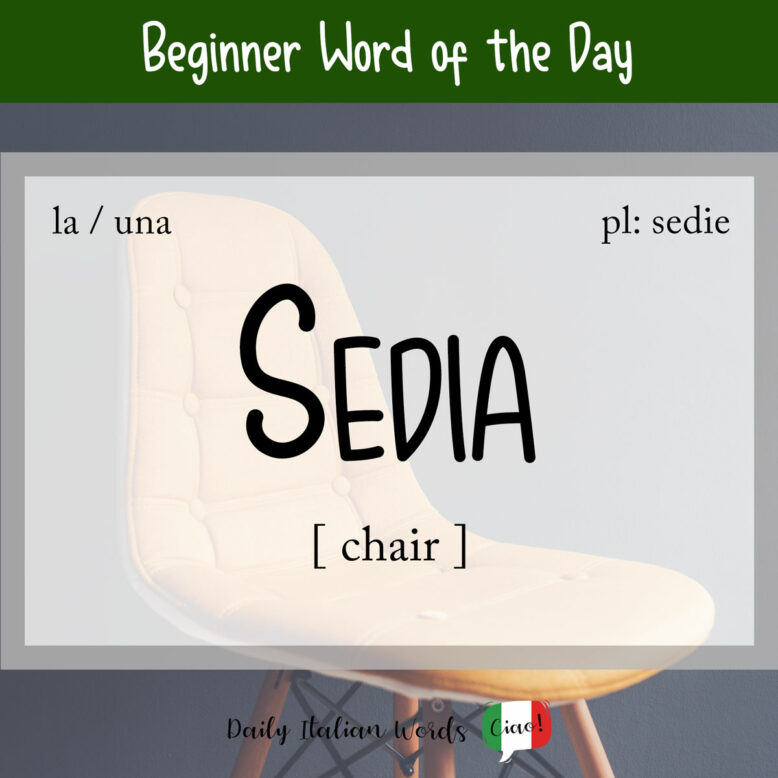The Italian word for chair is sedia. It comes from the ancient sieda which in turn derives from the verb sedere (to sit).

Sedia is a feminine noun, and the plural is sedie.
la sedia
una sedia
le sedie
delle sedie
A chair is normally made up of the following parts:
- schienale = back
- sedile = seat
- gambe = legs
- braccioli = arms
- fiancate = sides
Il sedile e lo schienale di questa sedia sono molto comodi, però i braccioli sono un po’ piccoli.
The seat and the back of this chair are very comfortable, but the arms are a bit small.

Did you know…?
Italy has a lot of dialects, and each of them is deeply linked to its region of origin. As such, many words in Italian are different when translated into one of these dialects. Sedia is no exception. In Piemontese, you say cadrega but in Campania it is seggia, just to name a couple.
Some different kinds of chairs include:
- sedia pieghevole = folding chair
- sedia a rotelle = wheelchair
- sedia elettrica = electric chair
- sedia a dondolo = rocking chair
- sedia girevole = swivel chair
- sedia da regista = director’s chair
- sedia a sdraio = deckchair
- sedia a sbalzo = Cantilever chair
Note: The word sedia cannot be used in reference to a child’s car seat or high chair. Instead, you’ll hear the terms seggiolino (lit. little seat) and seggiolone (lit. big seat), both of which are derivatives of seggiola, a synonym of sedia mostly used in Tuscany.
The set phrase Take a seat, as in to sit down in your designated seat to watch a movie at the theatre for example, can translate in various ways:
- accomodarsi = to sit down, to get comfortable
- sedersi = to sit
- prendere posto = to take a seat (posto means many things in Italian including location, spot and place)

Accomodarsi and prendere posto are the most appropriate to use in a formal situation.
Mi scusi signore, se si può accomodare gentilmente, lo spettacolo sta per iniziare. Grazie!
Mi scusi signore, se può prendere posto gentilmente, lospettacolo sta per iniziare. Grazie!
Excuse me sir, if you could kindly take a seat, the show is about to start. Thank you!
There is also prendere una sedia, but the latter works better in a more friendly situation, for example when there is an extra chair in the corner and one of your friends invites you to take it and join in on the conversation.
Ciao Gianni! Entra pure! Prendi una sedia lì nell’angolo e siediti con noi. Vuoi una birra?
Hi Gianni! Come in! Take a chair from the corner there and sit with us. Do you want a beer?

If you want to give an order instead, the verb sedersi in its imperative form is more appropriate: Siediti! or the formal version Si sieda! (Sit down!).
Finally, in archaic Italian, sedia was also a synonym for the throne as a symbol of temporal or spiritual power.
Idioms with the word ‘sedia’
Recitare per le sedie
Literal translation: to play for the chairs
English meaning: to act in front of a small number of spectators (in a theatre), to talk in vain
Scaldare la sedia
Literal translation: to warm the chair
English meaning: to occupy a job role without doing anything (to twiddle one’s thumbs)
Star seduti su due sedie
Literal translation: to be seated on two chairs
English meaning: to manoeuvre oneself between two different people or situations to make the most out of both, or wait to see which is more convenient (to want it both ways)
Heather Broster is a graduate with honours in linguistics from the University of Western Ontario. She is an aspiring polyglot, proficient in English and Italian, as well as Japanese, Welsh, and French to varying degrees of fluency. Originally from Toronto, Heather has resided in various countries, notably Italy for a period of six years. Her primary focus lies in the fields of language acquisition, education, and bilingual instruction.


